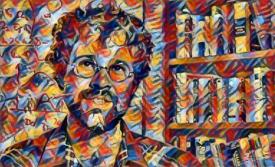
David Glowacki (that’s me) is originally from Milwaukee. I am a cross-disciplinary researcher, artist, author, and activist with interests spanning computer science, nanoscience, aesthetics, cultural theory, & spirituality. I have done a lot of work in VR applied to interactive scientific simulation and visualisation. I founded a research group called the ‘Intangible Realities Laboratory’ (IRL) who carry out open source research and software development at the immersive frontiers of scientific, aesthetic, computational, and technological practice.
I spend time working on various research project at the IRL’s home in Santiago de Compostela in Northern Spain at the CiTIUS Intelligent Technologies Research Centre. I graduated from UPenn in 2003, where I had the opportunity to study a range of subjects, including chemistry, mathematics, philosophy, comparative literature, and religions. In 2004 I obtained an MA in cultural theory as a Fulbright finalist at the University of Manchester (UK). In 2008, I completed a PhD in molecular physics at Leeds University (UK). I’ve had the good fortune to receive various research awards, including a Royal Society Research Fellowship, Philip Leverhulme award, ERC grant, and others.
As an artist, the immersive computational artworks I’ve worked on over the years have been experienced by more than 200,000 people on three continents. Artworks to which I’ve contributed include the multi-award winning ‘danceroom Spectroscopy’ digital art installation and the ‘Hidden Fields‘ performance, which have been installed at a number of well-known cultural and media venues across Europe, the USA, and Asia, including the Barbican Arts Centre (London), the ZKM | Center for Art and Media Technology (Karlsruhe, Germany), the London 2012 Olympics (London, UK), the Stanford University Art Institute (Palo Alto, California), the Bhutan International Festival (Thimphu, Bhutan), and others. Digital aesthetics isn’t the only art form I explore; sometimes I design altogether different types of performance art experiments…
I have published across several domains, including non-equilibrium molecular physics, classical & quantum dynamics, computational biochemistry, human-computer interaction, high-performance computing, computer graphics, evolutionary algorithms, machine learning & data science, digital aesthetics, interactive computational art, religion & power, cultural theory, optics, and scientific instrument development.
I’m interested the aesthetic metaphors that guide scientific imagination. This is particularly important in domains which cannot be seen with the naked eye, where our scientific intuition is guided by the aesthetic representations and metaphors we use to imagine phenomena which are otherwise invisible. In fact I would almost go so far to claim that imagery is the reality in these domains, profoundly impacting how we communicate these ‘realities’, in both research & educational contexts. Over the last few years, my group’s work in computational aesthetics has in fact driven a range of scientific research outcomes – e.g., the algorithms we’ve designed to make artworks have been fast enough to accelerate our scientific research. I like this research paradigm, with aesthetic enquiry and scientific enquiry locked in mutual dialogue, each pushing one another into new territories.
Lately, I’ve become interested in the overlap between sub-nanoscale aesthetics and spiritual aesthetics, both of which offer lenses for visualizing matter’s essential nature as energy. This aesthetic paradigm has proven incredibly useful in helping us to develop immersive digital experiences whose potency is comparable to psychedelic drugs.

I wanna get hydrated man….
“Irritated by the distraction, audience members proceeded to physically eject the Bristol University academic from the area, in what Mr Morris claims is the first such incident at a classical concert since the 18th century.”
YOU ARE A GOD AMONGST MEN